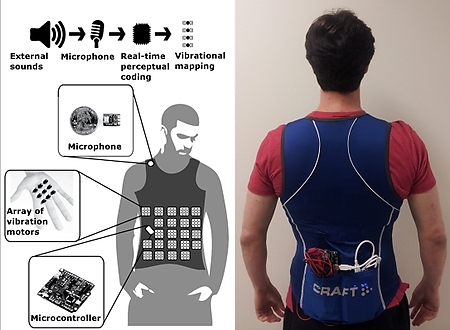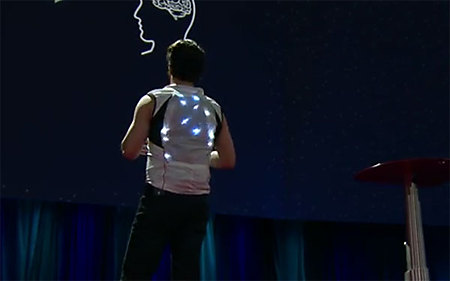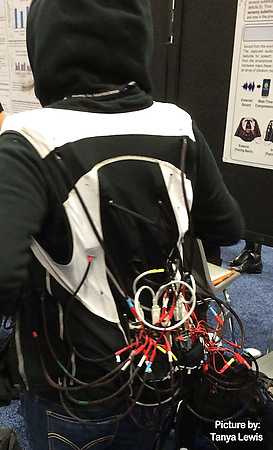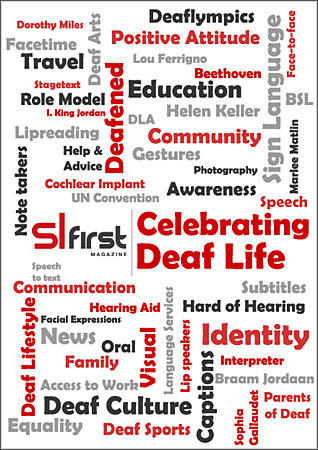Communication Aids3rd December 2015
Advances in Technology Opens New Options for Deaf People
A futuristic new vest could allow Deaf people to feel sounds and understand what people are saying
In recent years, science has moved on the communication options for Deaf people immeasurably. Always fascinated by where the next advance might take us, this story is right up there on the excitement scale and I can't wait to see how this develops. A team in the US are working on an entirely new way of communication in the hope that one day soon it might enable Deaf people to understand sounds – without ever needing to hear them!
Sight, hearing, touch, smell and taste are some ways of getting information about the world around us into our brains, but they are not the only way. The idea behind this new technology is called ‘sensory substitution’. They want to use a different way for one sense (touch) to replace another sense (hearing) and give Deaf people a completely new sense of ‘hearing’.

The team, neuroscientist David Eagleman and his graduate student Scott Novichare, based in Baylor College of Medicine in Texas, have come up with V.E.S.T (the Versatile Extra-Sensory Transducer). They use a collection of small vibrating motors (just like those in mobile phones) to create feelings and movement on a person’s back. The vest has a microphone that sends the sounds to a phone or tablet which then instructs different vibrating movements and patterns depending on what sound / word was heard by the tablet. High frequency noises will vibrate differently to low frequency noises and it even allows people to work out words just by how it feels on the wearer’s back. It also adjusts how long to vibrate for, and how strong the motors vibration should be – which can indicate the volume of the sound.
The VEST is also fairly discrete. While the current version has flashing lights so it is easy to see which motors are vibrating, the later versions are likely to get smaller and lighter, allowing people to easily wear it underneath clothes and no one would ever know about it.

David Eagleman did a TED talk back in March (subtitled) and explained that he had been testing with deaf people and after just a short amount of time, people could start feeling the words and sounds around them.
One of their testers was Jonathan, a Deaf man who practiced with the vest for 2 hours a day for 4 days. By the 5th day he was able to understand words being spoken into the connected tablet computer. It did not require him to learn that a specific vibration pattern means one word, while another pattern links to another word. All of that work is done without thinking about it, by the brain. With practice, you just start to learn how to understand the information it is receiving from the new sense. Eagleman believes that after wearing the vest for at least 3 months, it should give the user a similar experience to ‘hearing’, just like the way that some blind people can read Braille very quickly, without having to think about what they are feeling. They just know the words and sentences are coming to them.
 Eagleman also points out that when this device is ready for the general public, it will be significantly cheaper than current alternatives like a cochlear implant. He says that on average a cochlear implant costs $40,000 but the VEST only costs around $1000-2000 and eventually it is expected to be much cheaper, so he hopes that it could eventually allow Deaf people in poorer countries to also have the chance to ‘hear’ if they want that.
Eagleman also points out that when this device is ready for the general public, it will be significantly cheaper than current alternatives like a cochlear implant. He says that on average a cochlear implant costs $40,000 but the VEST only costs around $1000-2000 and eventually it is expected to be much cheaper, so he hopes that it could eventually allow Deaf people in poorer countries to also have the chance to ‘hear’ if they want that.
Deafness is only the beginning for this team as they hope one day that everyone might want an extra sense. They have also been experimenting with giving hearing people an extra sense but instead of using the vest to provide sound information they have tried financial (stocks) data and Twitter ‘mood data’ so you can literally feel the thoughts of the people around you.
When I first learned of the work they are doing, it all seemed a bit fanciful and pie in the sky, but the human tests seem really exciting and I wouldn't mind giving it a try myself to see what it adds to my every day communication.
Article by SL First Tech Team
posted in Technology / Communication Aids
3rd December 2015





